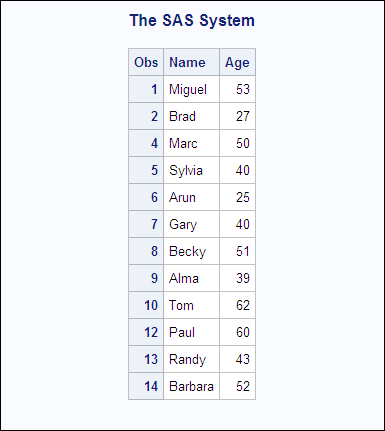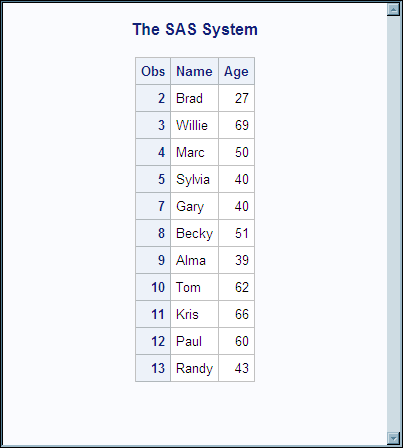OBS= Data Set Option
Specifies the last observation that SAS processes
in a data set.
| Valid in: | DATA step and PROC steps |
| Category: | Observation Control |
| Default: | MAX |
| Restrictions: | Use with input data sets only
Cannot use with PROC SQL views |
Syntax
OBS= n | nK | nM | nG | nT | hexX | MIN | MAX
Syntax Description
- n | nK | nM | nG | nT
-
specifies a number to indicate when to stop processing observations, with n being an integer. Using one of the letter notations results in multiplying the integer by a specific value. That is, specifying K (kilo) multiplies the integer by 1,024, M (mega) multiplies by 1,048,576, G (giga) multiplies by 1,073,741,824, or T (tera) multiplies by 1,099,511,627,776. For example, a value of
20specifies 20 observations, while a value of3mspecifies 3,145,728 observations.
- hexX
-
specifies a number to indicate when to stop processing as a hexadecimal value. You must specify the value beginning with a number (0–9), followed by an X. For example, the hexadecimal value F8 must be specified as
0F8xin order to specify the decimal equivalent of 248. The value2dxspecifies the decimal equivalent of 45.
- MIN
-
sets the number to indicate when to stop processing to 0. Use OBS=0 in order to create an empty data set that has the structure, but not the observations, of another data set.Interaction:If OBS=0 and the NOREPLACE option is in effect, then SAS can still take certain actions. SAS actually executes each DATA and PROC step in the program, using no observations. For example, SAS executes procedures, such as CONTENTS and DATASETS, that process libraries or SAS data sets.
Details
Examples
Example 1: Using OBS= to Specify When to Stop Processing Observations
This example illustrates
the result of using OBS= to tell SAS when to stop processing observations.
This example creates a SAS data set and executes the PRINT procedure
with FIRSTOBS=2 and OBS=12. The result is 11 observations, that is
(12 - 2) + 1 = 11. The result of OBS= in this situation
appears to be the observation number that SAS processes last, because
the output starts with observation 2, and ends with observation 12.
This situation is only a coincidence.
Example 2: Using OBS= with WHERE Processing
This example illustrates
the result of using OBS= along with WHERE processing. The example
uses the data set that was created in Example 1, which contains 15
observations.
First, here is the PRINT
procedure with a WHERE statement. The subset of the data results in
12 observations:
proc print data=Ages; where Age LT 65; run;
Executing the PRINT
procedure with the WHERE statement and OBS=10 results in 10 observations,
that is
(10 - 1) + 1 = 10. Note that
with WHERE processing, SAS first subsets the data and applies OBS=
to the subset.
The result of OBS= appears
to be how many observations to process, because the output consists
of 10 observations, ending with the observation number 12. However,
the result is only a coincidence. If you apply FIRSTOBS=2 and OBS=10
to the subset, then the result is nine observations, that is
(10 - 2) + 1 = 9. OBS= in this situation is neither
the observation number to end with nor how many observations to process;
the value is used in the formula to determine when to stop processing.
This example
illustrates the result of using OBS= for a data set that has deleted
observations. The example uses the data set that was created in Example
1, with observation 6 deleted.
Example 3: Using OBS= When Observations Are Deleted
The result of OBS= appears
to be how many observations to process, because the output consists
of 12 observations, ending with the observation number 13. However,
if you apply FIRSTOBS=2 and OBS=12, the result is 11 observations,
that is
(12 - 2) + 1 = 11. OBS= in
this situation is neither the observation number to end with nor how
many observations to process; the value is used in the formula to
determine when to stop processing.
See Also
Data Set Options:
Statements:
INFILE Statement in SAS Statements: Reference
WHERE Statement in SAS Statements: Reference
SAS Statements: Reference
System Options:
OBS= System Option in SAS System Options: Reference
For more information about using OBS= and WHERE processing,
see
Processing a Segment of Data That Is Conditionally Selected in SAS Language Reference: Concepts






